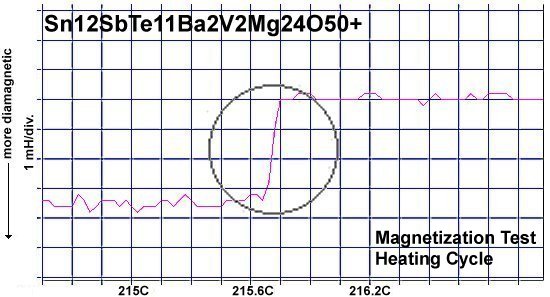
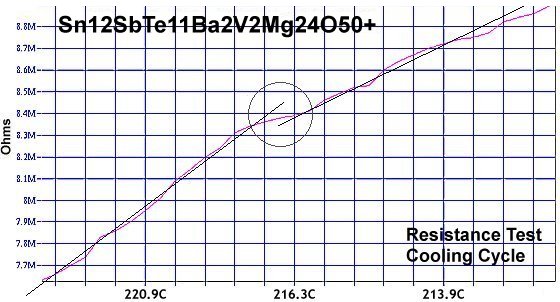


Though the scientific community continues to pretend that room-temperature superconductivity (RTS) has not yet been achieved, Superconductors.ORG herein reports the discovery of RTS formulations number 48 and 49.[1] These are the first superconductors to go above 400F. The critical transition temperatures (Tc) of these new superconductors are 209C (408F/482K) and 216C (420F/489K) - necessitating a reclassification of these materials from "warm" to "hot". The chemical formulas are Sn11SbTe10Ba2V2Mg22O46+ and Sn12SbTe11Ba2V2Mg24O50+ respectively. Compelling magnetization and resistance plots confirm that superconductivity is at work in both materials.
At upper left a strong Meissner transition appears as the 216C superconductor is heated through Tc. And at upper right, a companion resistance test shows a sudden drop in resistance, also near 216C. Due to the excessive heat, magnetization tests were performed with a miniature coil. So, readings are in millihenries instead of milligauss. The structural tools of high planar weight ratio and high dielectric constant were successfully applied to the previous 202C record-holder in order to make these discoveries.

|
Confirmation of 209C superconductivity came in the below plots. At lower left a Meissner transition of approximately 1 millihenry appears as the material warms through Tc. And, at lower right, pellet resistance suddenly drops 5 kilohms while cooling through 209C. Straight lines have been drawn through the noise to emphasize the resistance shift. A slope change and specific heat change also occur at Tc. 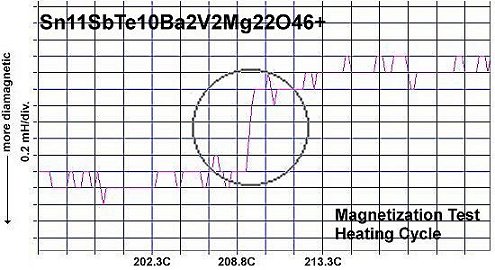
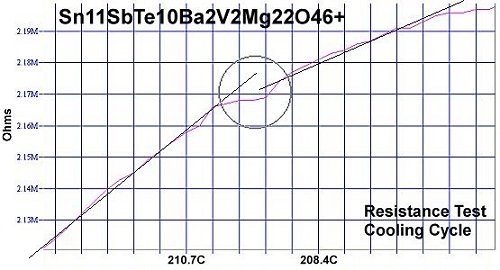 In some formulations, the non-superconductive bulk is on the threshold of a Mott transition - a shift from an insulator state to a metallic state. When this is the case, additional confirmation of low-volume-fraction superconductivity is possible. Below, a "Mott transient" can be seen dropping the bulk resistance from 4 megohms to near zero ohms in the 209C material. As minority-phase superconductivity is quenched, paired electrons are released to flood the non-superconductive bulk. This increases the electron density, causing a sudden resistance drop. To read more about Mott transients, click HERE. 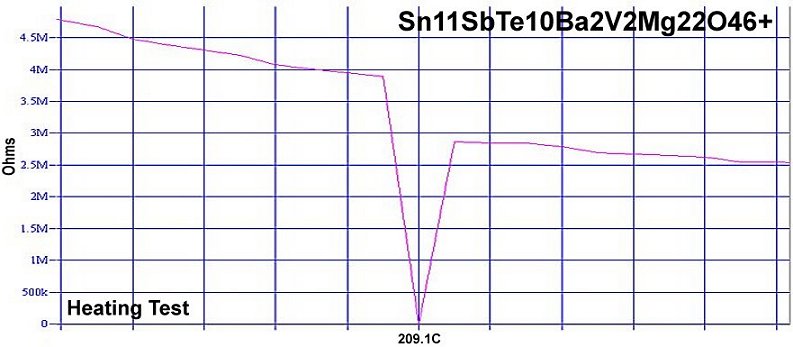 |
As shown below, high Tc has advanced steadily in the oxides through increasingly higher planar weight ratios and higher dielectric constants (K). With the same PWR, the high Kappa compounds have transition temperatures 60-80 degrees greater than the low Kappa formulations. Both of these new superconductors have twice as much vanadium in their anion layers as did the 202C material (circled upper right). The colossal dielectric constant of VO2 above 100C (approx. 60,000) [2] provides a Tc boost, even though the planar weight ratio drops when vanadium is substituted into a magnesium atomic site. (See target structure above left with arrow pointing at second vanadium site.)
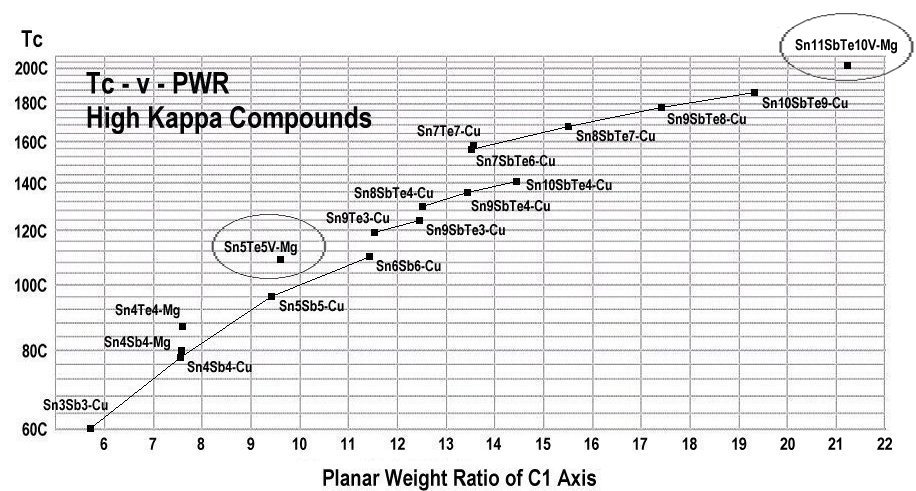
In order to maximize formation of such an elongated structure, these compounds were synthesized using the layer cake method, as shown below. The pellets had approximately 100 interference layers. And, even using this layering technique, the volume fraction is low, requiring very sensitive test equipment.
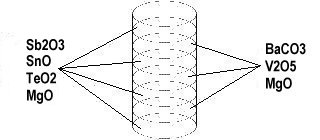
Stoichiometric ratios of the below chemicals were used for the ODD layers:
SnO 99.9% (Alfa Aesar)...and the below for the EVEN layers.
BaCO3 99.95% (Alfa Aesar) (decomposes to BaO during calcination, releasing the carbon as CO2) The chemical precursors were pelletized at 60,000 PSI and pre-sintered for
4 hours at 660C and 10 hours at 710C. Then sintering continued for 10 hours at 880C. Lastly the pellet was annealed for 10+ hours at 500C in flowing O2. Temperature was determined using an
Omega type "T" thermocouple and precision OP77 DC amplifier.
RE-PUBLICATION NOTICE: Elsevier Publishing, dba Elsevier Science, as well as Morris Communications, both print and broadcast divisions, are specifically prohibited from re-publishing any part of this news story.
E. Joe Eck
© 2017 - 2025 Superconductors.ORG
All rights reserved.
1. For a complete list of all 49, click HERE.
2. Zheng Yang, et al, Harvard School of Engineering and Applied Sciences, Harvard University, DOI: 10.1103/PhysRevB.82.205101, May 2010
 BACK to "News" page at Superconductors.ORG
BACK to "News" page at Superconductors.ORG